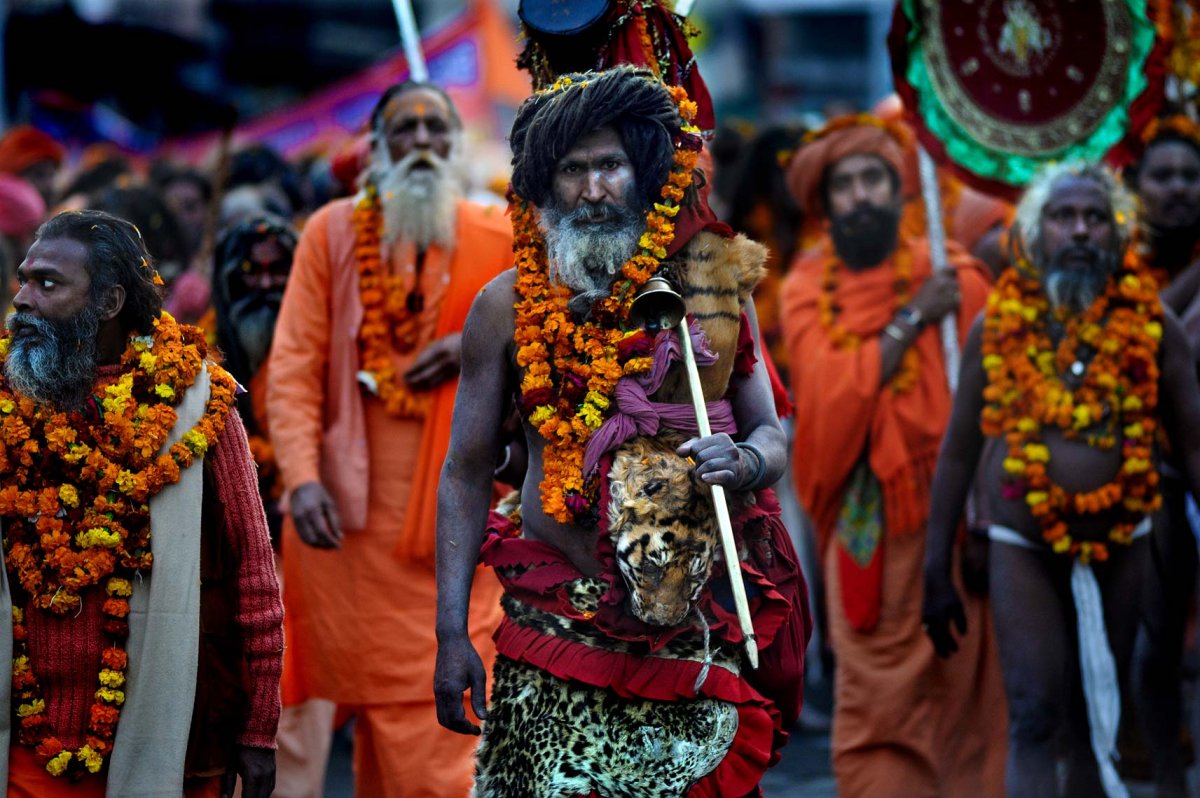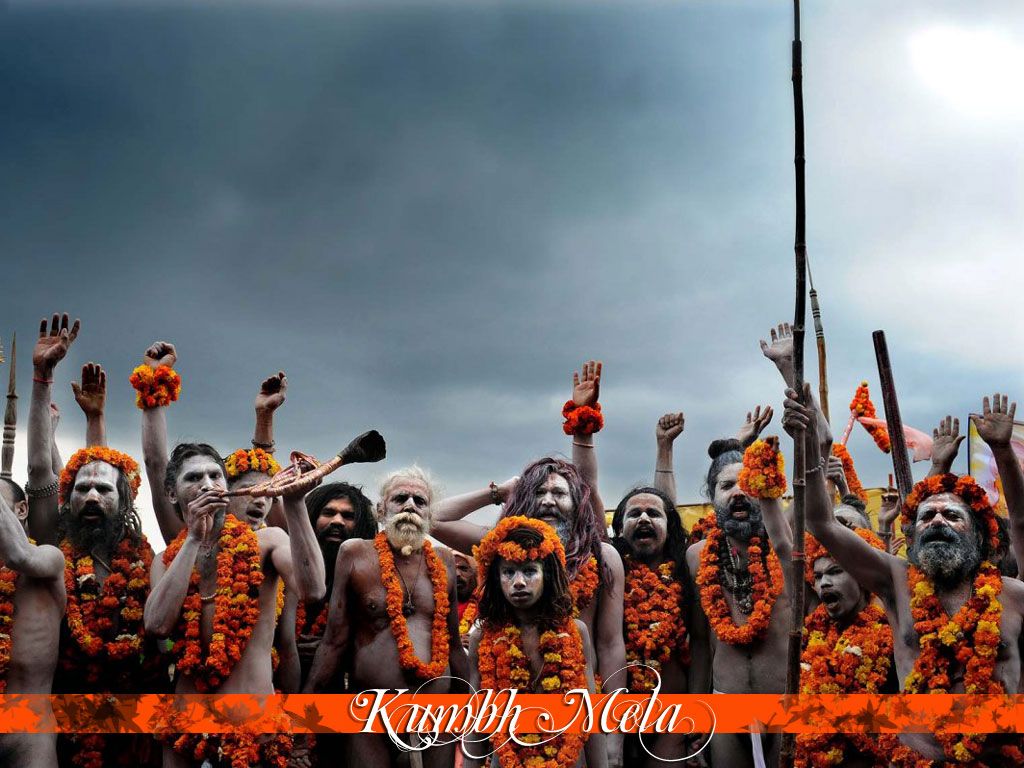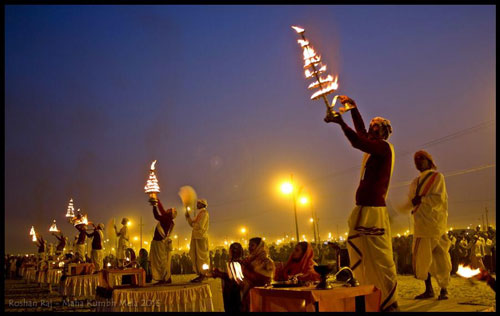
The Ardh Kumbh Mela is a fest that is celebrated for over a stretch of two long months, starting from the date of 5th January to 4th March in the city of Allahabad, Uttar Pradesh. The festival is celebrated with utmost zeal and enthusiasm and is held when the celestial setting of the stars are properly alligned – when Jupiter will be in Aries, the Sun and Moon in Capricorn; or Jupiter is in Taurus and the Sun in Capricorn.
The Maha Kumbh Mela is celebrated once in every 12 years and the Ardh Kumbh Mela, which literally translates to ‘Half Kumbh Mela’, takes place once in every 6 years.

The history behind hosting this 55-day long elaborate affair of Kumbh Mela is that it is believed, according to Hindu mythology, during the ‘Samudra Manthan’, which means the churning of the ‘Kshir Sagar’, the ocean of milk, four drops of ‘Amrit’, the nectar of immortal life had fallen at Prayag, Haridwar, Ujjain and Nasik on earth where the kumbh mela is now organised. From the fragrance of thousands of incense sticks to the echoes of numerous Naga sadhus and Babas chanting prayers, the Ardh Kumbh Mela is likely to have a lot of new experiences for you to see and experience. This religious gathering, which is likely to be attented by 15 crore people, has been recognized by UNESCO as an Intangible Cultural Heritage, with rituals like taking a dip in the holy water at the confluence, which is considered to relieve a person from all their sins. The Mela certainly can be a sight to relish with the exquisite and joyous evening ‘aartis’ to the sight of bare body Naga Sadhus smeared with ash to take the royal bath. Apart from dips and large gatherings, the Ardh Kumbh Mela of 2019 offers a lot of activities and experiences to savour and here is a travel guide with a list of top attractions at the Ardh Kumbh Mela, that can help you prepare your to-do list and could interest and attract you a little more than the others.
The Shahi Snan or the Rajyogi Snan, which literally translates into the Royal Bath, is actually the holy bath taken by the saints and sages of different religious groups in the sacred river before any other Hindu pilgrims. The ritual is that only after the sages and saints are done with their bath in the holy water at the confluence of the three rivers Ganga, Yamuna and Saraswati, the common people can take a dip. The devotees wake up early in the morning, as early as 3 a.m. and queue up for their morning bath. The moments of Shahi Snan are definitely worth capturing in the lens, and following are the dates for the upcoming Shahi Snan at this year’s Ardh Kumbh Mela: 1st Shahi Snan: 14th and 15th January 2nd Shahi Snan: 4th February 3rd Shahi Snan: 10th February
The Satsangs organised at the Ardh Kumbh Mela form a very important part of the celebrations. Devotees gather around to sit and listen for hours to the important and meaningful preachings of the spiritualist sadhus and sages. Arrangements of a number of ashrams and halls are made, where people can go and offer their prayers. You can go and listen to the preachings of spiritualist priests and saints, on what are their ideals of Hinduism and spiritualism.
The Kumbh Mela Langar is something that you would not want to miss, as it is the most coveted attraction of this 55-day long extravaganza. Langar is usually a communal meal arranged for all the visitors and devotees attending the Mela. The sacred offerings are served in the form of meals in the community area of the Mela and here people enjoy the mouth-watering bites of the langar offered to them free of cost. Soak in the madness of this elaborate extravaganza and indulge in the lip-smacking offerings of the langar.
One plunge into the holiest of waters promises purification of sins, cleansing of the soul, abundance of blessings and a straight ticket to the heavens. It, therefore, is no surprise that the Kumbh Mela is a human outpouring like no other. This year, 20 million people are expected to congregate in Prayagraj (Allahabad) between 15 January to 4 March for the Ardh Kumbh Mela. Here’s a guide to what is arguably the greatest gathering on Earth.
The Kumbh Mela is held four times over a period of 12 years, while the Purna Kumbh Mela is held every 12 years, cycling through Prayag, Haridwar, Ujjain and Nasik. The Ardh Kumb Mela, the one taking place now, is held every six years at either Haridwar or Prayagraj. And then there is the grandest of them all: the Maha Kumbh Mela, which is held every 144 years in Prayagraj. The last one was held in 2013. If you missed that, try and stick around till year 2157.

Watch the Peshwai
Peshwai is a procession that marks the beginning of the festival, and is celebrated with much pomp and show. Naga Sadhus make a grand entry on their horses, elephants or carriages, urging people from all over the world to join the procession, which is carried along a demarcated route. Saints also dance to the hymns of Lord Shiva, while they perform acrobats and stunts with their swords.
Take a holy dip
On the auspicious dates of the Shahi Snan, a special set of staunch believers are given priority to take a dip in the river. It is only towards the end of the royal bath that other visitors are given the chance. However, if you really wish to bathe in the holy waters on these auspicious dates, there’s no stopping you. Tour groups like Tornos India will make special arrangements for visitors on 15 January, 4 February and 10 February. (If you are staying at a luxury camp or hotel, check with them for access.)
Guests will have to join the camp a night before, as they set out for the dip much before sunrise. The sacrifice on sleep, however, might be totally worth it. The royal bath is supposed to be an experience unlike any other. The banks are beautifully decorated with rangoli, the air has a different energy with saints and devotees chanting and praying through the night.

The Kumbh Mela is so culturally rich that it is impossible to leave without photographs. Several groups offer curated tours led by expert photographers. Having experienced the mela before, they will guide you through the dos and don’ts, the keys spots to get the best photos, how to overcome the fear of getting close to people without invading their space, and more.
Discover Prayagraj and delve deep into its history with the guided Sangam Walk organized by the Government of Uttar Pradesh. It will include a walk around some popular tourist attractions such as Shankar Viman Mandapan, Bade Hanumanji Temple, the Patalapuri Mandir, Akshya Vat, Allahabad Fort and the Ram Ghat.
The government has organised river cruises for the mela. It will span from Sujawan Ghat to Rail Bridge (Naini Side) and then Boat Club Ghat to Saraswati Ghat and Kila Ghat. Five terminals will be built along the 20-km long route of the Ganga and Yamuna. In addition, organisers will give boats and vessels to enhance the festive experience.
Catch an aerial view of the largest gathering in the world. The Uttar Pradesh State Tourism Development Corporation (UPSTDC) will start a helicopter service which will take off from Arail helipad in trans-Yamuna area and fly to Sangam and other areas, beginning January 17, except the main snan dates.
The festival will be home to five cultural pandals, the Ganga Pandal being the biggest of all. Each pandal will showcase different performances, ranging from musical shows to traditional dances, with 2000+ folk and tribal artistes delivering 600 cultural programs. Sangeet Natak Academy (SNA) and SPIC MACAY (The Society for the Promotion of Indian Classical Music And Culture Amongst Youth) will entertain audiences with over 40 power-packed performances. Find more information on the dates and locations here.
Enjoy the lights and sounds
An initiative by the Yogi Government, the laser light and sound show has been lighting up the Prayagraj Fort Wall every day, since December.
An attraction that stands out is the creative hub, Kalagram, where visitors can get a slice of Indian art and culture. About 13 pavilions will house 15 shops sporting the beautiful craft items designed by artisans from across India.
The much-awaited Ardha Kumbh Mela in Prayagraj (Allahabad) started with much fanfare on January 15. This 5000-year-old tradition will witness a huge congregation for 48 days.
As per the legends, when the demons and gods were engaged in a war to get possession of amrita, believed to be the elixir of eternal life, a few drops of it fell on four places, which are today known as Haridwar, Nasik, Prayag and Ujjain. And the legends believed that those drops gave mystical powers to those places. It is still not clear since when, but Kumbha Mela is celebrated in those four places since as long as one can remember.
The usual Kumbha Mela is held after every three years, whereas the Ardha (half) Kumbha Mela is held after every six years in Prayag and Haridwar. However, Purna (complete) Kumbha Mela takes place after every 12 years in one of those four places, based on planetary movements.
www.tribaltoursinindia.com © All Rights Reserved, 2021